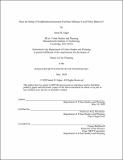Does the siting of neighborhood incarceral facilities influence local police behavior?
Author(s)
Edgar, Sarah H.
Download1193555926-MIT.pdf (1.748Mb)
Other Contributors
Massachusetts Institute of Technology. Department of Urban Studies and Planning.
Advisor
Amy Glasmeier.
Terms of use
Metadata
Show full item recordAbstract
This research studies NYPD Stop and Frisk data from before and after the reopening of the Brooklyn Detention Complex in 2012 to determine whether the introduction of carceral facilities to a neighborhood changes policing habits in the area. This research hopes to aid in wider discussions of devolution as a means for decarceration by answering an important question about the impacts of neighborhood siting. Though the research was inspired by the policy decision to close Riker's Island facilities in New York, the question of devolution is not limited to one city. Ultimately the research aims to help U.S. organizations and political officials interested in carceral devolution to better understand possible ramifications of neighborhood facilities. The main methodology for this research is quantitative analysis of pre-existing data applied to the natural experiment of the reopening of a neighborhood carceral facility. The NYPD publically hosts datasets for its "Stop, Question, and Frisk" program from 2003-2018 on the nyc.gov website. Within that timeframe, the Brooklyn Detention Complex reopened after years of inactivity. Methods focus on time disparity and difference in difference comparisons. The time from disparity and distance from facility are used as independent variables to form a gradient approach to analysis. Dependent and grouping variables describe characteristics of police behavior, including the number of stops, frequency of use of force, and race of persons stopped. I hypothesize that police behavior will become more aggressive near carceral facilities immediately after opening, in the form of a greater number of stops and arrests and a higher propensity toward using force. I also hypothesize an increase in the racial bias of these behaviors. Ultimately, I find few changes in police behavior apart from a consistent increase in officer use of force localized to the precinct home to the facility.
Description
Thesis: M.C.P., Massachusetts Institute of Technology, Department of Urban Studies and Planning, May, 2020 Cataloged from the official PDF of thesis. Includes bibliographical references (pages 52-53).
Date issued
2020Department
Massachusetts Institute of Technology. Department of Urban Studies and PlanningPublisher
Massachusetts Institute of Technology
Keywords
Urban Studies and Planning.